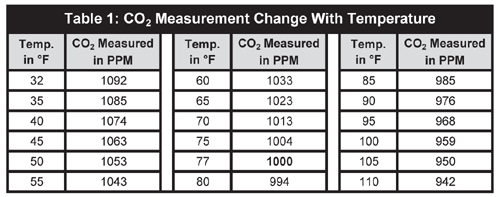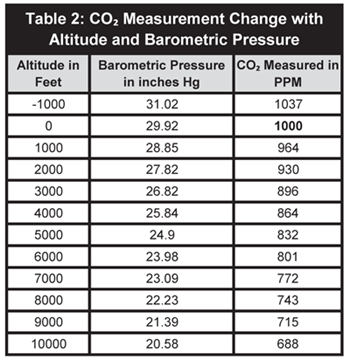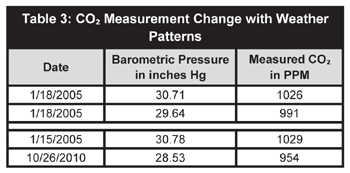Carbon Dioxide (CO2) in air is normally measured in Parts Per Million (ppm). At 1,000 ppm CO2, a volume or air containing one million air molecules would contain a mixture of 999,000 air molecules and 1,000 CO2 molecules.
The volume of air necessary to contain one million air molecules is affected by air temperature and air pressure, also called Barometric Pressure. As the pressure decreases, the volume needed to contain one million air molecules increases. The opposite is true of temperature. As the temperature decreases, the volume of air needed to contain one million molecules decreases. Although the volume of air is affected by temperature and pressure, the concentration of CO2 is not affected. If you started with 1,000 ppm of CO2, then you finish with 1,000 ppm of CO2 despite the changes in the air volume.
The most common CO2 sensors are known by the engineering term Non-Dispersive InfraRed, or NDIR. An NDIR CO2 sensor shines infrared light through a gas sample in a sample chamber. Sensitive photo-detectors measure the intensity of the infrared light after it passes through the gas sample. CO2 molecules are opaque to 4.26 micron infrared light while the rest of the air molecules are not. So the intensity of the infrared light is diminished proportionally to the number of CO2 molecules that are present. Measuring the resultant light intensity measures the number of CO2 molecules present.
The size of the NDIR sampling chamber is fixed and is open to the atmosphere so that air can move in and out. As explained above, the number of air molecules in a given volume is affected by temperature and air pressure but not the concentration of CO2. At low pressures or high temperatures, there will be fewer air molecules in the sample chamber, so there will also be fewer CO2 molecules, even though the ppm of CO2 hasn’t changed. Fewer CO2 molecules “fools” the sensor into thinking that the CO2 concentration is lower than it really is. At high pressures or low temperatures, there are more air molecules in the sample chamber and more CO2 molecules, even though the CO2 concentration hasn’t changed. More CO2 molecules “fools” the sensor into thinking that the CO2 concentration is higher than it really is. Therefore a CO2 sensor calibration will only be accurate at one temperature and one air pressure.
Calculating Temperature and Barometric Pressure Effects on CO2 Measurement
The following formula derived from the Ideal Gas Law relates changes in air volume to temperature, pressure and the number of molecules present:
ppm CO2 corrected = ppm CO2 measured * ((Tmeasured*pref) / (pmeasured*Tref))
- pmeasured = Current pressure, in the same units as reference pressure (not corrected to sea level)
- Tref = reference temperature, usually 25°C, 77°F, converted to absolute (298.15 for °C, 536.67 for °F)
- Tmeasured = Current absolute temperature, °C + 273.15, °F +459.67
- pref = reference Barometric Pressure, usually sea level, 29.92 in Hg, 760 mm Hg, 1013.207 hPa or 14.6959 psi
Table 1 uses the Ideal Gas Law formula above to show how the uncompensated CO2 measurement would change with temperatures from 32 °F to 110 °F. Initial conditions are 1,000 ppm CO2, 77°F and sea level Barometric Pressure. As seen in Table 1, the CO2 concentration varies by 150 ppm.

Barometric Pressure is directly affected by altitude, and Table 2 uses the Ideal Gas Law formula to show how the uncompensated CO2 measurement would change with altitudes of -1,000 to 10,000 feet. Initial conditions are 77°F and 1,000 ppm CO2 at sea level. As seen in Table 2, the CO2 concentration varies by 349 ppm.

Weather Effects on Barometric Pressure and CO2 Measurement
Heat entering our atmosphere creates weather patterns, and these patterns affect the Barometric Pressure by forming high pressure systems and low pressure systems. Fast moving storms can dramatically change the atmospheric pressure and effective altitude in only a few minutes.
About 15 miles from BAPI’s headquarters is an internet enabled weather station on the Mississippi River bluffs above the small town of DeSoto. Looking at historical data from that weather station from 2003 to 2011, the highest pressure, the lowest pressure and the biggest one-day pressure swing are shown in Table 3.

If the actual CO2 level was 1,000 ppm at sea level, then Table 3 shows what the measured CO2 concentration would be in DeSoto on those days. From January 15, 2005 until October 26, 2010, weather patterns alone changed the CO2 measurement by 75 ppm, which is the entire accuracy specification for a typical NDIR CO2 sensor.
On the single day of January 18, 2005, weather patterns changed the CO2 measurement by 35 ppm, which is almost 50% of the specified accuracy specification of a typical NDIR CO2 sensor.
The Combined Effect of Temperature and Barometric Pressure on CO2 Measurement
Temperature and Barometric Pressure affect CO2 measurement individually as well as in combination. Table 4 shows the measured CO2 concentration for the range of Barometric Pressures recorded in DeSoto from 2005 to 2010 along with temperatures from 50 to 90°F.

If the actual CO2 concentration was 1,000 ppm at 77°F and sea level, the measured CO2 concentration would vary by 161 ppm across the various temperature and Barometric Pressure ranges. That variance is more than the specified accuracy of the NDIR CO2 sensor.
Dynamic CO2 Measurement Compensation
Due to the constantly changing nature of Barometric Pressure and temperature and their effect on CO2 measurement, the only way to get an accurate CO2 measurement with an NDIR sensor is through temperature and Barometric Pressure compensation. That’s why all BAPI CO2 sensors have a built in Barometric Pressure sensor and temperature sensor.
Every eight seconds the BAPI sensor takes a CO2 reading then compensates that value based on the current temperature and Barometric Pressure. That’s one reason why BAPI’s CO2 sensors are the most accurate in the HVAC/R industry. There is also no need for an HVAC technician to spend valuable time manually entering the altitude value for the location into each and every sensor when it is installed. This makes the BAPI CO2 sensor one of the easiest to install, saving time and money.
If you have additional questions, please call your BAPI representative.



